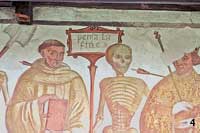THE BEAUTY OF THE MACABRE
Sonia Sbolzani
 It is strange how in Val Rendena there are some of the most interesting and remarkable representations of macabre dance. We are referring, in particular, to the frescos painted in the first half of the XVI century by Simone Baschenis (belonging to the well-known family of travelling painters from Bergamo) on the exterior facades of the churches of San Vigilio a Pinzolo and Santo Stefano a Carisolo.
It is strange how in Val Rendena there are some of the most interesting and remarkable representations of macabre dance. We are referring, in particular, to the frescos painted in the first half of the XVI century by Simone Baschenis (belonging to the well-known family of travelling painters from Bergamo) on the exterior facades of the churches of San Vigilio a Pinzolo and Santo Stefano a Carisolo.
Relatively unusual in Italy, the theme of macabre dance had its origins in XIV century Germany, and then spread to France and the Iberian peninsula (and from here, afterwards, to Latin American countries).
The same adjective "macabre", which Italian borrowed from French, comes from the expression danse macabré, referring to the "dance of the Maccabees", the heroic biblical characters whose faith was close to that of the dead.
There are various interpretations of the meaning of this type of visual art, the first of which is, naturally, a religious one: a lesson in "remember you must die", a call to reflect on how we are all equal before the common “scythe”, a warning and an exhortation to be humble and penitent. Then there are those who see in the macabre dancess a scathing satire against arrogance, decay and the excessive opulence of certain social classes. Equally, there is no lack of people that see in them an attempt to exorcise the end, thus explaining it in a propitiatory and apotropaic vein. Others believe, finally, that these representations are a parody of the processions that take place during secular spectacles which were on the increase in churches and churchyards at the beginning of medieval times (a parallel could also be drawn perhaps with puppet theatre or, in part, with the typical type of Neapolitan “guaratelle” puppets).
excessive opulence of certain social classes. Equally, there is no lack of people that see in them an attempt to exorcise the end, thus explaining it in a propitiatory and apotropaic vein. Others believe, finally, that these representations are a parody of the processions that take place during secular spectacles which were on the increase in churches and churchyards at the beginning of medieval times (a parallel could also be drawn perhaps with puppet theatre or, in part, with the typical type of Neapolitan “guaratelle” puppets).
 Macabre dances, which have inspired so much literature and art in general (just think of the famous verses by Lorenzo the Magnificent on the fragility of life, of Totò’s poems dedicated to death as a "level", of Angelo Branduardi’s songs starting with the very beautiful "Ballo in fa diesis minore” dedicated to the macabre dance of Clusone (BG), or the recordings by Rethel, Billa and Porter, to mention but a few), can still today act as a stimulus for private thought, which everyone needs to engage in to understand where they have reached and where they are going.
Macabre dances, which have inspired so much literature and art in general (just think of the famous verses by Lorenzo the Magnificent on the fragility of life, of Totò’s poems dedicated to death as a "level", of Angelo Branduardi’s songs starting with the very beautiful "Ballo in fa diesis minore” dedicated to the macabre dance of Clusone (BG), or the recordings by Rethel, Billa and Porter, to mention but a few), can still today act as a stimulus for private thought, which everyone needs to engage in to understand where they have reached and where they are going.
So as we are admiring Simone Baschenis’s paintings of the Rendena valley - with death dancing while nearby unwinds a long procession of noblemen and common people, old and young, laymen and religious people, warriors and workers, who are being clutched at sinisterly by sneering  skeletons – it may seem wrong to ponder on the end... in spite of a silly imported festival like Halloween which has made it a mere occasion for a good time.
skeletons – it may seem wrong to ponder on the end... in spite of a silly imported festival like Halloween which has made it a mere occasion for a good time.
The beauty of the macabre, however, lies in the fact that it can really restrengthen your spirit and provide new motivation, helping us to codify better our human experience.
In conclusion, the presence in this valley of such outstanding macabre dances only serves to reflect the sensitivity of its people for the mystery of the divine, or rather of life and death, that eternally dancing ghost that everyone, Christ included, comes up against sooner or later.
- Danza macabra, Chiesa di San Vigilio a Pinzolo
- Danza macabra - Pinzolo
- Danza macabra, particolare -
Tallin
- Danza macabra, particolare-
Chiesa di San Vigilio a Pinzolo